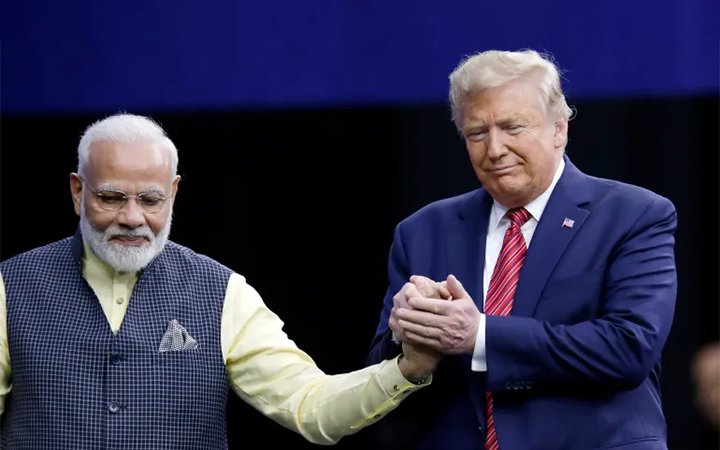When Indian Prime Minister Narendra Modi meets any male world leader, a bear hug is almost inevitable. Yet his embrace last week with Russian President Vladimir Putin in Moscow has stirred firm public pushback from both Washington and Kyiv.
In a series of statements over several days, US officials criticised Modi’s visit to Russia, the first since Putin launched a full-scale war on Ukraine in February 2022.
The US National Security adviser cautioned that strong ties with Russia were a “bad bet” for India. State Department spokesperson Matthew Miller said the US was concerned about India’s relations with Russia. And Eric Garcetti, the US ambassador to India, warned New Delhi that it could not take its friendship with Washington “for granted”.
Ukrainian President Volodymyr Zelenskyy was more direct. He referred to the deadly missile attack on Ukraine’s largest children’s hospital the day before Modi’s Moscow visit. “It is a huge disappointment and a devastating blow to peace efforts to see the leader of the world’s largest democracy hug the world’s most bloody criminal in Moscow on such a day,” he wrote on X.
So, did India miscalculate the geopolitical response to Modi’s trip? Has the visit to Moscow and the public show of warmth towards Putin damaged India’s relations with the US? And why do ties with Russia matter enough for India to take that gamble after years of investing in relations with the US?
Analysts say the answer lies in a combination of history, New Delhi’s confidence in its ability to juggle multiple complex relations, and a bet that former US President Donald Trump might well return to power and soften Washington’s tough stance against Russia.
‘My Friend Donald Trump’
On Saturday, after a sniper positioned on a roof outside a Trump rally in Pennsylvania struck the former president with a bullet, killing another person and wounding two others, a volley of reactions tumbled in from around the world.
Among them was an X post by Modi, who condemned the attack, describing Trump as “my friend”. The two leaders had a few years ago held joint public events in Houston and the Indian city of Ahmedabad, and a senior Indian government official told this writer the Modi administration was increasingly convinced that Trump might return to power in November.
The ex-president leads incumbent Joe Biden in polls in several swing states, and the image of Trump rising after being shot, fist in the air, blood streaking down his face, is expected to solidify his advantage over Biden.
“The election to the post of US president seems a foregone conclusion for Donald Trump, and PM Modi will be happy about it,” the Indian official said.
One way a Trump win would help India, analysts say, is by easing the pressure on New Delhi to turn away from Moscow.
“A second Trump administration, almost certainly, will care less about the optics of Russia-India ties,” said Christopher Clary, an assistant professor in political science at the University of Albany and a non-resident fellow with the Washington-based Stimson Center’s South Asia programme.
In his first term as president, Trump focused US strategic attention on Washington’s rivalry with Beijing, rather than on Moscow – a worldview that is in sync with India’s. New Delhi too views Beijing as its principal threat.
A Fine Balance
To be sure, India-Russia relations have a long history of their own. A legatee of the Soviet Union with which India enjoyed close relations during the Cold War, Russia has maintained ties with New Delhi.
Historically, it has been the biggest supplier of weapons and other defence equipment to India – from the MIG and Sukhoi fighter jets to, more recently, the S-400 anti-missile defence systems.
Since the start of Russia’s war in Ukraine, India has also dramatically ramped up its purchase of Russian crude. Russia is today India’s biggest supplier of oil, and those imports have led to the total volume of India-Russia trade – which used to hover about $10bn a year not long ago – skyrocketing to $63bn.
In the West, India has faced criticism for these oil purchases, which – the allegation goes – help finance Russia’s war. India has rejected the criticism and has argued that by buying Russian oil the West no longer wants, it is in fact helping keep global crude prices stable.
At the same time, India has in recent years doubled down on strengthening ties with the West, especially the US, whose help it sees as essential to warding off the perceived threat emanating from China’s rise. India’s defence dependence on Russia is lessening as it buys most new weapons systems from the US or European manufacturers.
India has insisted that it is merely exercising its strategic autonomy. But speaking last week in the eastern Indian city of Kolkata, Garcetti, the US ambassador, pushed back, saying that “there is no such thing as a strategic autonomy during a conflict”, referring to the war in Ukraine.
Modi’s visit to Russia also came a day before Zelenskyy landed in Washington, DC to attend the NATO summit. That made the optics of Modi’s trip bad from the perspective of the US where Zelenskyy is treated like a hero, said Seema Sirohi, a Washington, DC-based journalist and analyst.
Has India Crossed a ‘Red Line’?
The Russia trip also coincided with other sources of friction between India and the US. US prosecutors allege that an Indian government agent tried to orchestrate the assassination of Sikh separatist Gurpatwant Singh Pannun, a US national who holds dual citizenship with Canada. In June, the Czech Republic extradited, to the US, the Indian man who US prosecutors claim was trying to hire hitmen for the job.
In his comments in Kolkata, Garcetti referred to US concerns about India’s civil rights landscape – many rights groups have accused the Modi government of targeting critics. The US Commission on International Religious Freedom (USCIRF) has listed India as a “country of particular concern” for the past five years, claiming that New Delhi is guilty of “engaging in and tolerating systematic, ongoing, and egregious religious freedom violations”.
Still, analysts say that India and Modi have enough cards in their hands to be able to weather niggles in their relationship.
For all the poor optics of Modi’s Russia visit, those in the know in the US would have been “least surprised” by the trip, said Clary. “The strategic basis for the [India-US] relationship is sound and Modi’s visit does not undercut that basis,” he said.
Days before flying to Moscow, Modi skipped the annual leaders’ summit of the Shanghai Cooperation Organisation, led by China and Russia.
New Delhi is also expected to host a summit of the Quad later this year, said the Indian government official who spoke on condition of anonymity. China views the Quad grouping of democracies in the Asia Pacific, which consists of Australia, India, Japan and the US, as a challenge to its rise.
Later this year, the Russian city of Kazan will also host a summit of the BRICS grouping. The BRICS, consisting of Brazil, Russia, India, China and South Africa until last year, has now expanded to include Saudi Arabia, Egypt, Iran, the United Arab Emirates, and Ethiopia.
Whether Modi returns to Russia for a second time in three months, or whether he skips that meet, could point to just how much India is willing to test ties with the US, the government official said.
For now, said Sirohi, India and the US know that they need each other too much to risk upsetting their partnership.
“New Delhi and Washington will understand each other’s compulsions,” she said. “And the larger US-India relationship is far too important to be derailed by one speed bump.”
Or one hug.
Despite the backlash from the US and Ukraine, Modi’s visit to Russia and his warm interaction with Putin highlight India’s strategic balancing act. As global geopolitics evolve, India continues to navigate its alliances, betting on a possible Trump return to power to ease tensions. Keep an eye on how these dynamics unfold and their implications on international relations.

